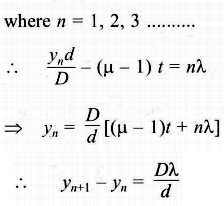The correct option is (d).
Explanation:
Suppose S1 and S2 are the slits at a distance d from each other. Distance of screen be D. Let P be a point where there is a bright fringe. A glass plate is placed in the path of the ray from S1 to P.

The path difference between the rays in absence of glass plate is

In presence of the glass plate, the optical path length of the ray from ,S1 to P will be different. The total optical path length for this ray is given by

Where p is the refractive index of the glass plate and t is its thickness.
Hence, the new path difference is given by

and y = yn distance of the nth bright fringe from the central fringe

Hence, the fringe width remains constant.